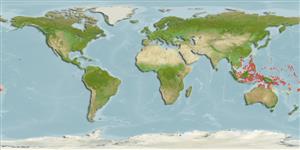Teleostei (teleosts) >
Blenniiformes (Blennies) >
Blenniidae (Combtooth blennies) > Salariinae
Etymology: Praealticus: Latin, prae = in front of + Latin, altus, alticus = nutritious.
More on author: Peters.
Environment: milieu / climate zone / depth range / distribution range
Ecology
Marine; reef-associated; depth range 0 - 6 m (Ref. 86942). Tropical
Western Pacific: South China Sea.
Size / Weight / Age
Maturity: Lm ? range ? - ? cm
Max length : 9.0 cm TL male/unsexed; (Ref. 90102)
Short description
Morphology | Morphometrics
Dorsal
spines
(total): 13;
Dorsal
soft rays
(total): 18-20;
Anal
spines: 2;
Anal
soft rays: 18 - 21. Head and body greyish brown with small white spots; median fin with white dots. Dorsal fin deeply notched; segmented caudal rays usually 13-14, branched middle 6-9; pinnately branched supraorbital tentacle; lacking nape cirri; posterior rim of anterior nostril with small cirrus, typically unbranched; upper and lower lip margins smooth; with occipital crest (higher in males); last dorsal ray and caudal peduncle connected by membrane; elongate body, depth at anal-fin origin ca. 7.7-7.9 in SL. Maximum size to 9 cm TL (Ref. 90102).
Facultative air-breathing (Ref. 126274); Adults inhabit exposed rocky shores (Ref. 90102). Oviparous. Eggs are demersal and adhesive (Ref. 205), and are attached to the substrate via a filamentous, adhesive pad or pedestal (Ref. 94114). Larvae are planktonic, often found in shallow, coastal waters (Ref. 94114).
Life cycle and mating behavior
Maturity | Reproduction | Spawning | Eggs | Fecundity | Larvae
Oviparous, distinct pairing (Ref. 205).
Randall, J.E. and K.K.P. Lim (eds.), 2000. A checklist of the fishes of the South China Sea. Raffles Bull. Zool. Suppl. (8):569-667. (Ref. 36648)
IUCN Red List Status (Ref. 130435)
Threat to humans
Harmless
Human uses
More information
Age/SizeGrowthLength-weightLength-lengthLength-frequenciesMorphometricsMorphologyLarvaeLarval dynamicsRecruitmentAbundanceBRUVS
ReferencesAquacultureAquaculture profileStrainsGeneticsElectrophoresesHeritabilityDiseasesProcessingNutrientsMass conversion
Tools
Special reports
Download XML
Internet sources
Estimates based on models
Preferred temperature (Ref.
123201): 27.1 - 29.3, mean 28.8 °C (based on 1167 cells).
Phylogenetic diversity index (Ref.
82804): PD
50 = 0.5001 [Uniqueness, from 0.5 = low to 2.0 = high].
Bayesian length-weight: a=0.00741 (0.00335 - 0.01640), b=3.02 (2.83 - 3.21), in cm total length, based on LWR estimates for this (Sub)family-body shape (Ref.
93245).
Trophic level (Ref.
69278): 2.0 ±0.00 se; based on food items.
Resilience (Ref.
120179): High, minimum population doubling time less than 15 months (Preliminary K or Fecundity.).
Fishing Vulnerability (Ref.
59153): Low vulnerability (10 of 100).
